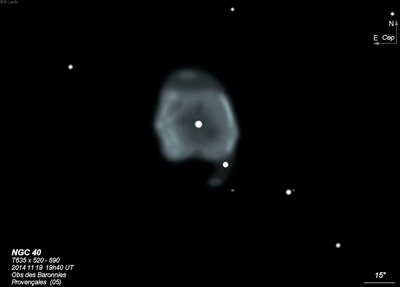Bow-Tie nebula
Bow-Tie nebula

William Herschel discovered NGC 40 = H IV-58 = h8 on 25 Nov 1788 (sweep 886) and recorded, "a star about 9th mag, surrounded with vF milky nebulosity; other stars of the same size are perfectly clear from that appearance. The star is either not round or double; but I am in the north and above the pole, I could not view it sufficiently to determine it. Less than 1' in diameter." On 20 Nov 1829 (sweep 228), JH logged "a star 11m with a luminous atmosphere 30" to 40" diameter." On 29 Oct 1831 he noted "a * 10m with strong nebulous atmosphere 15" diameter. Exactly round and pretty suddently fading away makes a double star class 5 with a star preceding."
Based on Crossley photographs, Curtis (1918) described, "Central star about mag 10. The nebula resembles a truncated ring from the ends of which extend much fainter wisps. The brighter central portion is 38"x35" in PA 14°, while the total length along this axis is about 60"."
200/250mm - 8" at 100x; a bright central star is surrounded by an easy halo.
300/350mm - 13.1" (12/7/85): at 166x, bright central star visible centered within a fairly small prominent disc.
13.1" (10/12/85): moderately large, bright central star surrounded by a moderately bright halo at 166x and 214x using a UHC filter.
400/500mm - 17.5" (12/30/99): at 100x appeared (unfiltered) as a slightly elongated, moderately bright disc surrounding a bright mag 11.5 central star. A slightly fainter mag 12 star lies 1.0' SW. This is a low excitation PN with an OIII/H-beta ratio of just 0.4 and at 100x there was a noticeable enhancement using the H-beta filter, while it dimmed with an OIII filter. At 220x, a star was intermittently visible at the SW edge and the PN was slightly elongated SSW-NNE. The UHC filter gave the best response at this power. The surface brightness appeared irregular -- darker around the central star and slightly brighter along the west and east side of the rim. At 280x, the faint star I noted earlier was barely off the SW edge and the PN was weakly annular with a brighter rim along the west and east side and a darker center. The SW and NE ends of the halo were clearly weaker, though. 380x provided a nice view with subtle irregularities in the interior.
17.5" (11/1/86): bright, moderately large, round. Contains a prominent mag 11.5 central star surrounded by a fairly bright halo.
900/1200mm - 48" (10/23/14): this showpiece, annular planetary was observed unfiltered (low-excitation) at both 488x and 813x and a remarkable amount of detail was visible. The main section of NGC 40 is nearly round and 0.7' in diameter but outer extensions on the north and south ends increase the dimensions to roughly 1.0'x0.8' SSW-NNE. The darker interior surrounding the blazing mag 11.5 central star (WC8-type carbon Wolf-Rayet) has a very uneven surface brightness and is slightly darker to the southwest of the central star.
The irregular rim in much brighter along fairly narrow N-S strips on the west and east side. The western rim is the brighter one and somewhat patchy with a slightly darker notch to the south of its center. At its north end is a small, faint extension. The rim is more uniform in brightness on the eastern side.
A very faint, thin outer loop curls north and west at its north end of the main disc! A small, detached, elongated patch floats near its north edge, but slightly south of the tip of the outer loop to its east. A very faint star or stellar knot is involved in this patch.
The rim is very weak on the south side and an easy star is at the southwest end. A faint, very small detached piece was easily visible at the southern extremity [32" SSW of the central star] of NGC 40. This patch forms the eastern vertex of a small triangle with a star ~10" NW (noted earlier) and a fainter star 10" SE.
Notes by Steve Gottlieb